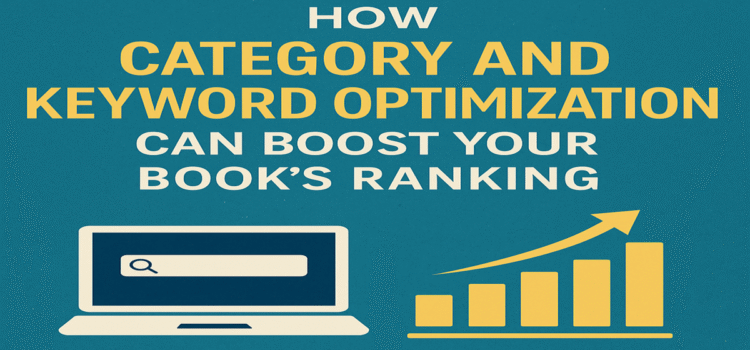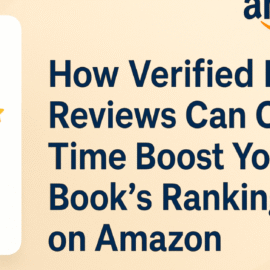
As an author or publisher, getting your book discovered on Amazon isn’t just about having a great cover or well-written prose. In fact, some of the most powerful tools at your disposal are hidden in plain sight—namely, your book’s categories and keywords.
Amazon is the world’s largest bookstore, but it’s also one of the biggest search engines. That means if you want your book to reach the right audience, you have to speak Amazon’s language. And that language? It’s all about category and keyword optimization.
In this post, we’re going to dive into how these two elements work, why they’re essential for ranking higher on Amazon, and how you can use them to give your book the visibility it deserves—whether you’re launching a brand-new title or breathing new life into your backlist.
What Is Category Optimization?
When you publish your book through Amazon Kindle Direct Publishing (KDP), you’re asked to choose two categories. But did you know Amazon actually has thousands of hidden subcategories—and that you can appear in up to 10 categories if you ask?
Category optimization means going beyond the default options and strategically selecting the most specific and least competitive categories where your book can thrive. Why? Because ranking in a smaller niche category is often easier—and it gives your book the coveted “Best Seller” badge faster.
Example:
Let’s say you wrote a mystery novel. Choosing just “Fiction > Mystery” is too broad. But selecting “Fiction > Mystery > Cozy > Cats” (yes, that exists!) could mean far less competition—and a faster path to the Top 10.
What Is Keyword Optimization?
When readers search on Amazon, they’re typing in phrases like:
- “romantic comedy with older characters”
- “dystopian teen series”
- “quick keto cookbook for beginners”
These are keywords, and your ability to match those phrases determines whether your book shows up in search results. Amazon allows you to enter seven keyword phrases during setup, and those entries play a huge role in your visibility.
But here’s the catch: You need to choose keywords that readers are actually typing, not just what you think describes your book.
How These Two Elements Work Together
Think of categories as the aisle your book is sitting in and keywords as the GPS that helps readers find that aisle. You need both working together to:
- Increase your book’s visibility
- Reach more relevant readers
- Boost your ranking and sales
- Qualify for promotional tools like BookBub, Amazon ads, and newsletters
Without smart optimization, your book could be buried under thousands of titles readers will never see.
How Amazon’s Algorithm Uses Categories and Keywords
Amazon’s algorithm (A9) takes many factors into account when deciding what books to show a reader. Here’s how categories and keywords influence it:
- Sales velocity in a category tells Amazon your book is popular. If you’re selling well in a niche, you’ll climb the ranks faster.
- Click-through rate from search results tells Amazon your cover/title/keywords are relevant.
- Conversion rate (how many people buy after clicking) tells Amazon your book satisfies readers’ search intent.
The takeaway? If your keywords and categories are off-target, Amazon won’t know who to show your book to. You’re essentially marketing in the dark.
The Benefits of Optimizing Keywords and Categories
📈 1. Higher Ranking = More Sales
Amazon’s Top 100 lists (and even the Top 20 of each category) get premium placement. That means more visibility and more chances to sell—especially if you earn the orange “#1 Best Seller” or “Hot New Release” badge.
🔍 2. Better Search Discovery
Optimized keywords help your book show up in relevant searches. That means more organic traffic, which means you don’t always have to rely on ads.
🎯 3. Reaching the Right Audience
The tighter your category and keyword match, the more likely you are to reach readers who are ready to buy. That means better reviews, lower return rates, and more engagement.
🔄 4. Long-Term Discoverability
Even months after launch, well-optimized books can continue to generate passive sales because they continue to rank in the right places.
How to Optimize Your Categories
✅ Step 1: Use Amazon’s Category Trees
Start by searching Amazon for books similar to yours. Scroll down to the product details and look at the categories they rank in. Write those down.
Use tools like:
- Amazon Browse Categories
- Publisher Rocket (paid tool for research)
- KDP Help Desk (to request additional categories)
✅ Step 2: Pick Specific, Not Generic
Avoid categories like “Fiction” or “Non-Fiction.” Instead, go for niche ones like:
- Fiction > African American > Women
- Non-Fiction > Business > Time Management
- YA > Social Issues > Bullying
✅ Step 3: Request More Categories
Once your book is live, email Amazon KDP support and ask to be added to up to 10 categories. Provide the exact category path, and they’ll usually update it within 24 hours.
How to Optimize Your Keywords
✅ Step 1: Think Like a Reader
What would someone search to find your book? Use phrases that:
- Describe the content (e.g., “clean romance” or “spiritual memoir”)
- Describe the problem (e.g., “overcome anxiety” or “time management tips”)
- Describe the audience (e.g., “for teens” or “for Christian women”)
✅ Step 2: Use Keyword Tools
Free and paid tools like:
- Amazon Search Bar Auto-Suggest
- Publisher Rocket
- KDP Rocket (built into Publisher Rocket)
- Google Trends
These tools help uncover what people are already searching for.
✅ Step 3: Update and Test
The keywords you enter in your KDP dashboard can be changed anytime. If your book isn’t getting traction, try swapping out the weaker keywords with more focused ones.
Pro Tip: AI-Powered Optimization Services
If all this feels overwhelming, you’re not alone. At Pubvertise, we use AI-powered tools and real-time data to help authors optimize both categories and keywords based on actual sales trends, competition levels, and reader behavior. This ensures that your book doesn’t just exist on Amazon—it thrives.
We analyze:
- Current category competition
- Long-tail keyword opportunities
- Reader intent and niche saturation
Then we match your book with high-opportunity rankings that can move you up the charts, fast.
Final Thoughts: Small Tweaks, Big Impact
Category and keyword optimization might not sound as exciting as writing a new book or designing a cover—but they are some of the most impactful marketing moves you can make.
Why spend time writing a book only to let it vanish into Amazon’s black hole?
With just a few tweaks, you can make your book easier to find, more likely to sell, and better positioned for long-term success. Whether you’re publishing your first title or managing a full catalog, smart optimization is the quiet powerhouse that keeps your sales engine running.
Want Help Ranking Higher?
Our Category & Keyword Optimization service uses AI + expert analysis to position your book for growth. Let us unlock the Amazon algorithm for you—and help you reach that Top 20 badge and beyond.
📘 Visit Pubvertise.com to learn more and get started.

